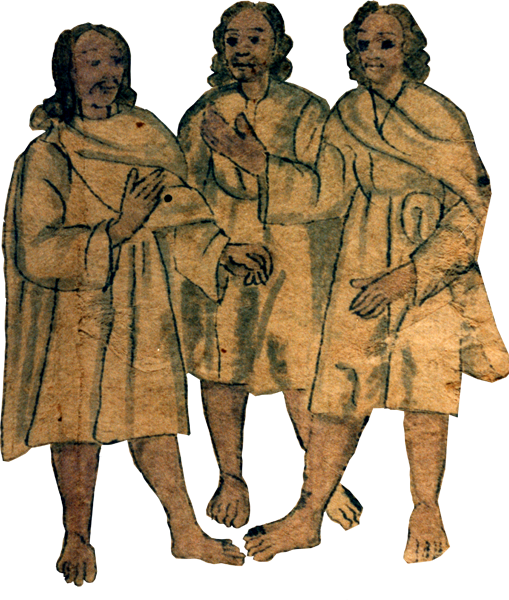Bk. V, f. 2r., three indigenous men standing (colonial attire)
In this scene, appearing in Book V, folio 2 recto, three indigenous men are standing, barefooted and dressed in knee-length, loose-fitting, white-cotton Spanish-colonial style pants and long-sleeved tunics. The men on the right and left also wear cloaks tied at the shoulder over their tunics, a symbol of their high status. The men are outlined in black. Their skin is washed with a flesh-tone watercolor. Their hair reaches to their shoulders and appears wavy. At least one, the man on our left, has a pencil-thin mustache. The man on the right and the one on the left are both gesturing with their right hands, suggestive of some degree of authority.
The text at the top of the page identifies the men as don Domingo, don Gaspar, and don Andrés Moteczozomatzin (Moctezuma in the plural reverential). [SW]
tres hombres indígenas de pie (era colonial)
En esta escena vemos a tres hombres indígenas descalzos y vestidos con túnicas de algodón blanco, mangas largas hasta las rodillas, acorde al típico estilo colonial. Los hombres de la derecha e izquierda visten capas alrededor de su cuello como símbolo de status social alto.
Los figuras están delineadas en tinta negra, y pintadas con acuarelas semejantes al color de su piel. Su pelo llega a los hombros y parece ser ondulado. Por lo menos uno (el hombre de la izquierda) posee un bigote fino. Los hombres de la derecha y la izquierda están gesticulando con sus manos, sugieriendo cierto grado de autoridad.
El texto al principio de la página identifica los hombres como don Domingo, don Gaspar y don Andrés Moteczozomatzin (Moctezuma en veneraciones grupales).

